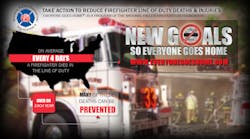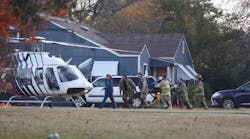It’s OK to be aggressive, just do it safely.
Fire prevention can no longer be an afterthought.
Fire departments must have a zero policy for failing to buckle up and for tobacco use.
Those are just a few of the recommendations included in the final report from Tampa 2 released Tuesday morning by the National Fallen Firefighters Foundation.
“I am very pleased with the outcome of the summit. We had a diverse group of people who are very dedicated to making things safer,” said NFFF Executive Director Ron Siarnicki.
In March -- exactly 10 years after the first gathering of firefighters and stakeholders – some of those same people sat down in Tampa to review the 16 Life Safety Initiatives. Are they relevant? Do they need to be tweaked?
The veterans were joined by about 50 future fire service leaders who obtained scholarships to attend the conference. A number of corporate partners provided the opportunity for the younger folks to attend.
We referred to them as our ‘up and comers,’ he said with a laugh. “These people are our future…”
Some of the issues raised by participants were strikingly similar to those mentioned during the initial summit.
“For true culture change to happen, everyone in the fire service, from firefighter to fire chief, must take accountability to promote safe actions and stop unsafe actions,” authors wrote.
“The company officer has to take the lead. They are the ones on the scene first, and they are responsible for the welfare of their crews,” Siarnicki said, adding that there’s no time to wait for a command officer to arrive.
Those company officers must enforce safe behavior from the onset, including making sure firefighters buckle up and monitoring their speed en route to the incident.
A video produced by the NFFF to promote the Tampa 2 discussions features Kentland Vol. Fire Co. in Prince George’s County, Md.
“They were selected because they are widely known as an aggressive department. But, they’re doing it safely,” he said.
While Tampa 2 participants like the numbers – the 32 percent annual reduction in LODDs from 2004-2012 – they know it’s not enough. Their goal is to keep the number of deaths under 50 per year.
"Although the future programs, strategies and events have yet to be determined, one thing is clear: Too many firefighters die and are injured in preventable events each year…”
Authors wrote: “Although this is a difficult dimension to measure, TAMPA 2 participants generally felt that there has been real progress in relation to firefighters and fire service leaders accepting the call for accountability. White papers have been produced on each of the FLSIs, and the Everyone Goes Home program has a national presence. The push toward a “culture of safety” has produced backlash among certain circles, but this debate has also prompted healthy discussion on how we can preserve the best of the fire service while also initiating changes that save lives. And such controversies bring the conversation to the kitchen table, exposing more firefighters to the discussion,” according to the report.
Here are a few issues highlighted by the scholarship participants:
- The “all-inclusive” FLSIs are difficult to apply at the company level. …As currently stated, most of the FLSIs are either too broad or at too high a level for company officers to implement. They recommended adding components within the initiatives at the strategic, tactical and task levels. They also pointed out the need for more ideas for customizing the initiatives based on local-level resources, staffing and other factors. As noted later in this report, this is a sentiment that was shared broadly across the TAMPA2 participants, regardless of age or fire service experience.
- Modernize the message. …Suggested revising the FLSIs to “support the TwitterAge,” using shorter messages and multimedia formats to spread the message. They also recommended the development of a Smartphone or tablet app, a wallet card and a taskbook approach for training. At the same time, participants cautioned that it’s important not to oversimplify the messages being conveyed in the FLSIs.
- Fitness remains one of the biggest barriers to success. “…Stressed that physical ability testing should be established as a baseline standard throughout the fire service and that a special focus on the fitness level of volunteer firefighters is needed.
- Get the company officer/crew boss involved. Scholarship participants focused heavily on the role of the company officer/crew boss in creating cultural change. Participants recommended developing a formal and structured company officer/crew boss development program at the national level. They also recommended the dissemination of best practices that company officers can customize and adapt to the needs of their departments.
- • Engage individuals. The younger generation is often characterized as having a “me” focus, and the scholarship participants indicated that it is important for cultural change efforts to promote individuality and personal accountability, empowering firefighters at the individual level to implement and apply the FLSIs. The “officers of now” need to provide an opportunity for all members to be equal participants.
Another issue that always surfaces is the need for life safety education.
“Fire prevention can no longer be an afterthought. We must incorporate prevention in initial and ongoing firefighter training and develop more scientifically based, effective fire and life-safety education programs that resonate with the public. Fire service leaders must promote and support model building and fire codes and residential sprinklers, including incentives for homebuilders…”
Authors noted that there have been some local successes with the building code and residential fire sprinklers. Community risk reduction concepts are starting to garner more success. Vision 20/20 has also made important advancements in quantifying the value of prevention and education programs to build support and funding for them. But fire prevention remains an afterthought in too many departments, in terms of funding and in the interest level of engagement by firefighters.
In addition to reviewing each initiative, the participants weighed in issues including behavioral health, leadership, wildland firefighting, transportation trauma, training and education, crew boss development and firefighter survivability.
Download Report: TAMPA2: Carrying the Safety Message into the Future (PDF)








